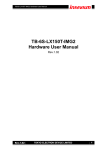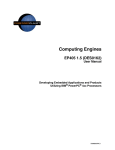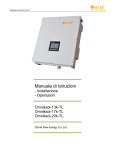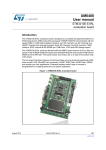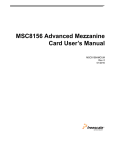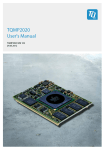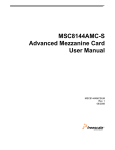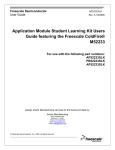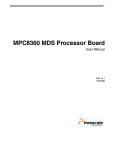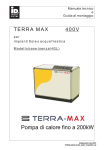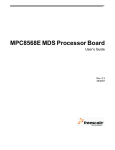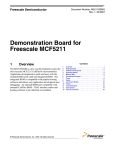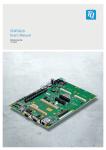Download EP8548A 1.2 (DES0212), User Manual
Transcript
AdvancedMC® EP8548A 1.2 (DES0212) User Manual Developing Embedded Applications and Products Utilizing Freescale™ PowerQUICC™ III 85xx Processors P5010000086RA00 ry Pre lim ina 2 2 February 2007 Preliminary P5010000086RA00 AdvancedMC®, EP8548A 1.2 Copyright Copyright © 2007 Embedded Planet, LLC. All Rights Reserved. This manual is copyrighted by Embedded Planet, LLC. No part of this document may be copied or reproduced in any form or by any means without the express written permission of Embedded Planet, LLC. Notice ry Embedded Planet, LLC., reserves the right to modify the information contained herein as necessary. Embedded Planet assumes no responsibility for any errors which may appear in this document. Information in this document is provided solely to enable system and software implementers to use Embedded Planet products. Trademarks Pre lim ina This manual in whole or in part, is to be considered the intellectual property of Embedded Planet. This document is intended for the sole purpose of the owner of an Embedded Planet product. Neither the document, nor reproductions of it, nor information derived from it is to be given to others, nor used for any other purpose other than for development of Embedded Planet computing engine applications, by original, authorized owners of Embedded Planet products. Embedded Planet, Linux Planet, Blue Planet, RPX LITE, and RPX LICC are trademarks or registered trademarks of Embedded Planet. Freescale, PowerQUICC, and QUICC Engine are trademarks of Freescale Semiconductor, Inc. IBM and PowerPC are registered trademarks of International Business Machines, Inc. AdvanceTCA and ATCA are registered trademarks of PCI Industrial Computer Manufacturers Group (PICMG). AdvancedMC and MicroTCA are trademarks of PICMG. Wind River Systems, VxWorks, and Tornado are registered trademarks of Wind River Systems, Inc. All other names and trademarks are the property of their respective owners and are hereby acknowledged. P5010000086RA00 Preliminary 2 February 2007 3 Pre lim ina ry AdvancedMC®, EP8548A 1.2 4 2 February 2007 Preliminary P5010000086RA00 AdvancedMC®, EP8548A 1.2 Contents ry Chapter 1 Introduction .......................................................................................................... 9 Functions .........................................................................................................................................9 First Steps ......................................................................................................................................10 How to Use This Manual ............................................................................................................10 About Embedded Planet .............................................................................................................10 Customer Support .................................................................................................................11 Contact Embedded Planet ...................................................................................................11 Document Conventions ...............................................................................................................12 Reference Documents ..................................................................................................................12 Pre lim ina Chapter 2 Description ......................................................................................................... 13 PowerPC Processor ......................................................................................................................16 SDRAM Organization .................................................................................................................17 FLASH Organization ...................................................................................................................17 Processor I/O Interface Signals ..................................................................................................17 I2C Devices ....................................................................................................................................19 Operating Modes ..........................................................................................................................20 Thermal ..........................................................................................................................................20 Firmware .......................................................................................................................................20 Restoring MAC Addresses .........................................................................................................20 Chapter 3 Getting Started ................................................................................................... 23 Serial Monitor Connection ..........................................................................................................23 Network Connection ...................................................................................................................23 Power Up .......................................................................................................................................24 Chapter 4 Setup ................................................................................................................... 25 SRIO Configuration .....................................................................................................................25 MMC Configuration ....................................................................................................................25 JTAG/COP Configuration ..........................................................................................................26 Chapter 5 Connectors and Headers ................................................................................... 27 Power .............................................................................................................................................27 Processor Monitor Port ................................................................................................................27 Ethernet Port .................................................................................................................................28 JTAG/COP Port ...........................................................................................................................28 MMC Serial Port ...........................................................................................................................29 MMC Debug Port .........................................................................................................................29 12 VDC Fan Header .....................................................................................................................29 AMC Connector ...........................................................................................................................29 Chapter 6 Operation ............................................................................................................ 33 System Reset Pushbutton ............................................................................................................33 Board LEDs ...................................................................................................................................33 Ethernet Port LEDs ......................................................................................................................33 User Applications .........................................................................................................................34 RS-232 Connection .......................................................................................................................34 P5010000086RA00 Preliminary 2 February 2007 5 AdvancedMC®, EP8548A 1.2 Contents (continued) Chapter 7 Board Control and Status Registers ................................................................ 35 Chapter 8 Memory and Interrupts ...................................................................................... 39 Memory Map ................................................................................................................................39 External Interrupts .......................................................................................................................39 No. 2-1. 2-2. 2-3. 2-4. A-1. List of Tables No. 1-1. 2-1. 2-2. 2-3. 4-1. 4-2. 4-3. 5-1. 5-2. 5-3. 5-4. 5-5. 5-6. 5-7. 6-1. 6-2. 7-1. 7-2. 7-3. 7-4. 7-5. 6 Pre lim ina List of Figures ry Appendix A Mechanical Dimensions ................................................................................. 41 Title Page Simplified Block Diagram .............................................................................................13 EP Board - Top View.......................................................................................................14 EP Board - Bottom View ................................................................................................15 FLASH Address and Data Lines...................................................................................18 Mechanical Dimensions .................................................................................................42 Title Page Hardware Features ...........................................................................................................9 FLASH Devices ...............................................................................................................18 I/O Signals.......................................................................................................................18 I2C Address Map ............................................................................................................20 SERDES Port Configuration (SW1[1:3]) ......................................................................25 MMC Configuration (SW4[1:4]) ...................................................................................25 JTAG/COP Configuration (J6) .....................................................................................26 Monitor Port Pinout (P11) .............................................................................................28 Ethernet Port Pinout (J2, J3)...........................................................................................28 COP Port Pinout (P12) ...................................................................................................28 MMC Serial Port Pinout (J7)..........................................................................................29 MMC Debug Port Pinout (P13).....................................................................................29 12 VDC Fan Header Pinout (P1)...................................................................................29 AMC Connector (P15) ....................................................................................................30 Board LEDs ......................................................................................................................33 Ethernet Port (J2, J3) LEDs.............................................................................................34 BCSR0 - Board ID ............................................................................................................35 BCSR1 - CPLD Code Revision ......................................................................................36 BCSR2 - FLASH Status...................................................................................................36 BCSR3 - Reserved ...........................................................................................................36 BCSR4 - FLASH, EEPROM, LED Control and User Switch Status .........................37 2 February 2007 Preliminary P5010000086RA00 AdvancedMC®, EP8548A 1.2 List of Tables (continued) No. Title Page BCSR5 - Monitor, Ethernet, Reset Control ..................................................................37 BCSR6 - Interrupt Status ................................................................................................37 BCSR7 - Interrupt Masking ...........................................................................................38 BCSR8 - SERDES Control ..............................................................................................38 BCSR9 - MMC Debug Status.........................................................................................38 Memory Map...................................................................................................................39 External Interrupts..........................................................................................................39 Pre lim ina ry 7-6. 7-7. 7-8. 7-9. 7-10. 8-1. 8-2. P5010000086RA00 Preliminary 2 February 2007 7 Pre lim ina ry AdvancedMC®, EP8548A 1.2 8 2 February 2007 Preliminary P5010000086RA00 Introduction Chapter 1 ry The EP8548A board is a single-width, full-height advanced mezzanine card (AMC) based on the Freescale MPC8548E PowerQUICC III processor. The EP8548A board can operate as an AdvancedMC module within an AdvancedTCA® system when plugged into an ATCA® carrier or MicroTCA® chassis. The board can also operate as a stand-alone module for rapid application development outside of the integrated ATCA or MicroTCA environment. Functions Pre lim ina The functions included on the EP board are listed in Table 1-1. Table 1-1. Hardware Features Entity Description Form factor Single-width, full-height AMC.0 compliant Processor MPC8548A (up to 1.33 GHz) SDRAM Up to 2 GBytes, x64 DDR2, SODIMM FLASH Up to 128 MBytes, x32 NVRAM Up to 1 MBytes, x16 Ethernet 2 10/100/1000, front panel RJ-45 2 10/100/1000, AMC connector port 0 and port 1 Serial port 2-wire RS-232, front panel RJ-45 Serial RIO AMC.4 compliant x1/x4 data, AMC connector port 4, 5, 6, 7 1.25, 2.5, or 3.125 Gbaud; 8b/10b encoding Serial EEPROM I2C Serial temperature Serial real-time clock (battery-backed P5010000086RA00 Preliminary BCSR Board control and status registers (CPLD) LED - Power status - 2 user controlled LEDs - Ethernet PHY controlled - MMC controlled Switch - 4-position user switch - Processor configuration - MMC configuration Debug JTAG/COP port access for software debug and programming 2 February 2007 9 AdvancedMC®, EP8548A 1.2 Chapter 1 - Introduction Table 1-1. Hardware Features (continued) Entity Description Power requirements 12 VDC @ 3A maximum from barrel connector (stand-alone) or via AMC backplane connector 3.3 VDC @ 100 mA maximum via AMC backplane connector Operating temperature1 0° C to 70° C (32° C to 158° F) ry NOTES: 1. Contact Embedded Planet for information about an industrial temperature version board. 2. The means of disconnection from the mains power supply is the plug. 3. No serviceable parts. First Steps Pre lim ina While it may be tempting to jump right into application development, it is recommended that you take a few minutes to review the Getting Started material, paying special attention to the following recommended first steps. 1. Register your EP board; go to Support at www.embeddedplanet.com. 2. Complete the steps in Chapter 3 when ready to connect and powerup the EP board for development. Reminder You must register your EP board to become eligible for customer assistance or more detailed technical support from Embedded Planet. Refer to Customer Support in this chapter. How to Use This Manual 1. Refer to Chapter 2 for a description of the board features and functions. 2. Refer to Chapter 3 for quick start information: connection, configuration, and powerup. 3. Refer to Chapter 4 for setup information including switch and jumper settings. 4. Refer to Chapter 5 for a description of the connectors and headers available on the board. 5. Refer to Chapter 6 for information about the operation of the EP board. 6. Refer to Chapter 8 for memory map and interrupt information. About Embedded Planet Embedded Planet is a leading single board computer and embedded systems solution provider. Our capabilities range from standard off the shelf single board computer products and embedded operating systems to full custom design and intellectual property solutions. In 1997, Embedded Planet pioneered the Design, Develop, Deploy process for embedded systems engineering. This process allows our customers to take advan- 10 2 February 2007 Preliminary P5010000086RA00 AdvancedMC®, EP8548A 1.2 Chapter 1 - Introduction tage of production tested, reusable product designs in all phases of system development to reduce time to market, project risk, and development costs. Embedded Planet products help remove risk and shorten the design cycle through production tested, integrated hardware and software designs. CPU module design is becoming more complicated with advanced memory interfaces and highly integrated communications processors. Our production proven modules help OEMs eliminate the risky and time intensive design and verification of the CPU module and focus on their value added application. Develop Embedded Planet products provide early access to production modules for all members of the engineering team to allow for a parallel development path. Software developers get access to turnkey platforms with the operating system of their choice ready to run out of the box. Hardware developers gain access to production designs and prototyping systems to test advanced system functionality. Fully integrated software and hardware platforms simplify and shorten the development cycle. Deploy Embedded Planet products are ready to go to market today. Our designs are production proven and ready to be manufactured in quantity. We offer full lifecycle management to simplify the deployment of your embedded solution. Pre lim ina ry Design Customer Support Embedded Planet provides complete support for our product line. Embedded Planet technical support includes product assistance for EP firmware and hardware. Technical support can assist with setup, installation, configuration, documentation, product related questions, and expansion guidelines. Second level software support for SDP’s is handled through our partners. We also provide development tools for all of our PowerPC boards. Using our online support system our technical support engineers can assist you with questions regarding Embedded Planet products. Via a browser our support team can access your system directly and quickly answer your technical questions. Please contact us today to learn more; refer to Contact Embedded Planet in this chapter. Contact Embedded Planet Embedded Planet 4760 Richmond Road, Suite 400, Warrensville Heights, OH 44128 Phone: 216.245.4180 Fax: 216.292.0561 www.embeddedplanet.com Company E-mail Directory P5010000086RA00 Preliminary Marketing: [email protected] Sales: [email protected] Information Request: [email protected] Technical Support: [email protected] Webmaster: [email protected] 2 February 2007 11 AdvancedMC®, EP8548A 1.2 Chapter 1 - Introduction Document Conventions This document uses standard text conventions to represent keys, display items, and user data inputs: Display Item Italic - Identifies an item that displays on the screen such as a menu option or message (e.g., File > Open). User Data Input Bold - Identifies any part of a command or user entry that is not optional or variable and must be entered exactly as shown. Italic - Identifies any part of a command or user entry that is a variable parameter. ry [ ] - Identifies any part of a command or user entry that is an optional parameter; text within the brackets follows the previously described conventions. KEY - Identifies a specific key that is not alphabetic, numeric, or punctuation: File Names Pre lim ina Press ENTER Press ESC V M (press and release each key in sequence) Press CTRL-ALT-DEL (press all keys in sequence simultaneously). Name - Indicates a file or directory name. Example: file.h /bin Reference Documents 12 • MPC8548E PowerQUICC III Integrated Host Processor Reference Manual • AMC.0 R2.0, Advanced Mezzanine Card, Base Specification • AMC.4 Rx.x, Advanced Mezzanine Card, Serial RapidIO 2 February 2007 Preliminary P5010000086RA00 Description Chapter 2 ry This chapter provides some description of the EP8548A board features including the PowerPC processor, external interfaces, and u-boot firmware. Figure 2-1 is a simplified block diagram of the EP board. Figures 2-2 and 2-3 show the top and bottom views of the board layout. These figures show the headers unpopulated (i.e., without pins or connectors). Pre lim ina LEDS QUAD GBIT XCVR SERDES RS-232 JTAG/COP (P12) SERIAL (P11) 10/100/1000 ETHERNET (J2, J3) x1/x4 SRIO/SERDES ETSEC1/2/3/4 RGMII MPC8548E UART0 USER SWITCH SW3 CLOCKS DDR BUS AMC CONNECTOR (P15) SEP SRTC 32.768 KHZ STTM I2C1 CFG SWITCH SW1 SEP STTM SPI CFG SWITCH MMC SW4 IPMB-L/I2C LOCAL BUS CPLD 16.67 MHZ 25 MHZ 33.33 MHZ SDRAM SODIMM NVRAM FLASH JTAG/ BDM (P13) SERIAL (J7) T00328A Figure 2-1. Simplified Block Diagram MPC8548E Clocks Refer to PowerPC Processor in this chapter. All of the clocks used on the EP board are generated locally. There are a few distinct clocking environments on the board: • • • System clock and real-time clock. Ethernet clock. SERDES clock. An onboard 33.33 MHz clock oscillator (ECS-3953C or equivalent) generates the system clock (SYSCLK) input to the MPC8548E processor. This is the primary P5010000086RA00 Preliminary 2 February 2007 13 AdvancedMC®, EP8548A 1.2 Chapter 2 - Description MMC JTAG/BDM AMC CONNECTOR POWER SW5 PWR-1 MONITOR (SERIAL) P13 J6 BT1 1 P11 1 J7 P12 P15 J1 J3 10/100/1000 ETHERNET DDR2• SODIMM P1 SW2 MMC SERIAL 12V FAN T00330A Pre lim ina JTAG/ COP ry J2 Figure 2-2. EP Board - Top View clock input to the device. A zero delay buffer (CY2304 or equivalent) is used to distribute the 33.33 MHz clock to the processor and to also divide this clock input to provide a 16.67 MHz real-time clock (RTC) input to the processor. The 16.67 MHz clock input can be used to clock the time base of the processor and to clock the global timers in the programmable interrupt controller (PIC) of the processor. The CLK_OUT of the processor routes to the CPLD for timing purposes. The actual frequency of the CLK_OUT signal depends on the clock selection in the processor. An onboard 25 MHz crystal oscillator (FX532 or equivalent) provides the clock input needed by the Ethernet transceiver. The Ethernet controller (eTSEC) of the processor requires a 125 MHz external clock input. The Ethernet transceiver generates the 125 MHz clock to the processor (EC_GTX_CLK125) from its 25 MHz clock input. The high-speed SERDES interface of the processor requires either a 100 MHz or 125 MHz LVDS clock reference to operate SRIO at either 1.25, 2.5, or 3.125 Gbaud. A frequency synthesizer device (ICS840001-34) generates the 100 MHz or 125 MHz clock from an onboard 25 MHz crystal oscillator (FX532 or equivalent) input. An LVDS clock fan-out buffer (ICS8545)selects either the 100 MHz or 125 MHz single-ended input and distributes it to the processor as an LVDS reference clock (SD_REF_CLK, SD_REF_CLK). NOTE: An option to clock the SERDES interface from CLK3 of the AMC connector is provided. Additionally an option to source CLK3 to the AMC connector is provided. These options are controlled from a BCSR register; refer to Table 7-9. Memory The board has DDR2 SDRAM memory, FLASH memory, and NVRAM memory (Table 1-1). DDR2 SDRAM is supported via an SODIMM socket. The memory bus is 64-bit bus width; refer to SDRAM Organization in this chapter for additional information. There is no ECC option. Access to the SPD functions of the SODIMM module is from I2C port 1 of the processor; refer to Table 2-3 for its I2C address. 14 2 February 2007 Preliminary P5010000086RA00 AdvancedMC®, EP8548A 1.2 Chapter 2 - Description P14 SW4 SW1 T00331A Pre lim ina Figure 2-3. EP Board - Bottom View ry SW3 The FLASH memory is Spansion™ MirrorBit. The memory bus is 32-bit bus width; refer to FLASH Organization in this chapter for additional information. The NVRAM memory is battery-backed SRAM memory. The memory device is an STMicro M68AWxxxD or equivalent. The memory bus is 16-bit bus width. An onboard battery provides backup power for the NVRAM device. NOTE: The local bus address and data lines are multiplexed. An external demultiplexer, controlled by the address latch enable (LALE) signal, is used to separate the address and data bus. The local bus is buffered using a data latch for the address lines (SN74LVC32373A or equivalent) and a bus transceiver for the data lines (SN74LVCH32245A or equivalent). RS-232 Ethernet There is one RS-232 serial port available at the front panel (P11). The port communicates via UART0 of the processor. The serial port uses an Intersil ICL3225E RS-232 transceiver or equivalent. There are two 10/100/1000 Ethernet ports available at the front panel (J2, J3). Two additional 10/100/1000 Ethernet ports are available at the AMC connector. The Ethernet ports communicate via eTSEC1, eTSEC2, eTSEC3, and eTSEC4 of the processor and use a Marvell® 88E1145 quad transceiver device. The interface to the processor is RGMII. Port 3 of the transceiver device routes to AMC port 0 and port 4 of the transceiver device routes to AMC port 1 in the common options region of the AMC port mappings. The interface to the AMC connector is SERDES using SGMII protocol. An external PHY or SERDES device is required to complete the interface to the media. The MII management connection (MDC/MDIO) to the processor is for configuration and monitoring of the transceiver device. The default Ethernet PHY addresses are 0b00000, 0b00001, 0b00010, and 0b00011 respectively. BCSR P5010000086RA00 Preliminary Board control and status registers (BCSR) provide hardware control and status to the processor. BCSR bits selectively enable/disable and configure board features, and control LEDs, read switch settings, and provide status indications. The BCSR registers of the EP board are implemented in control logic within a complex pro- 2 February 2007 15 AdvancedMC®, EP8548A 1.2 Chapter 2 - Description grammable logic device (CPLD). Refer to the Chapter x for BCSR programming information. There is one serial EEPROM (SEP) on the local I2C port 1 bus; refer to Table 2-3 for its I2C address. This SEP device is available for user application storage. The SEP is a 2-wire, AT24C04 device or equivalent. STTM There is one serial temperature and thermal monitor (STTM) device on the local I2C port 1 bus; refer to Table 2-3 for its I2C address. The STTM part is a 2-wire, digital temperature sensor. Its functionality is equivalent to the Microchip TCN75 part. The minimum resolution provided by this part is a 9-bit temperature conversion. SRTC There is one serial real-time clock (SRTC) device on the local I2C port1 bus; refer to Table 2-3 for its I2C address. It provides clock and calendar functions for the board. Counters for tenths/hundredths of seconds, seconds, minutes, hours, day, date, month, year, and century are provided. Its functionality is equivalent to the STMicrodevices M41T81 part. An onboard battery provides backup power for the SRTC device. MMC Pre lim ina JTAG/COP ry SEP The P12 header provides access to the COP port of the processor for debug access. Additionally P12 can be configured with jumper settings to give access to the CPLD JTAG. Refer to JTAG/COP Configuration in Chapter 4. The module management controller (MMC) funtionality required for AMC.0 compliance is implemented in an MCF5213 Coldfire processor. The MMC communicates with the ATCA carrier or microTCA carrier hub over the IPMB-L bus using I2C protocol. The carrier and MMC communicate through a limited set of IPMI commands. Two serial temperature sensors and a serial EEPROM implement the temperature sensor and FRU information storage device requirements for AMC.0 compliance. These devices are accessed via the SPI bus of the Coldfire processor. Additionally access to the RS-232 serial port and JTAG/BDM port of the Coldfire processor are provided for development purposes. Refer to Chapter 5 for more information and pinouts for the connectors. PowerPC Processor The EP board incorporates an MPC8548E PowerQUICC III integrated host processor. This 32-bit processor includes an integrated PowerPC core and peripheral interfaces that can be used in a variety of embedded networking, telecom transmission and switching, 3G wireless infrastructure, storage, and high-end imaging applications. The MPC8548E processor incorporates: • • • • • • • • • 16 e500 core scaling up to 1.33 GHz. DDR memory controller operating at up to 667 MHz data rate. Local bus controller operating at up to 166 MHz. OCeaN switch fabric. Dual UART (DUART). Dual I2C interfaces (master or slave mode). Serial RapidIO interface unit. PCI Express interface unit (not accessible on EP board). Four enhanced three-speed Ethernet controllers (eTSEC). 2 February 2007 Preliminary P5010000086RA00 AdvancedMC®, EP8548A 1.2 Chapter 2 - Description • • • • • Two PCI/PCI-X controllers (not accessible on EP board). Programmable interrupt controller (PIC). Four-channel DMA controller. System performance monitor. Integrated security engine. SDRAM Organization 2 GByte 128M x 64, 200-Pin DDR2 SDRAM SODIMM Micron MT16HTF12864H or equivalent 2 bit bank address (BA0-BA1) 14 bit row address (A0-A13) 10 bit column address (A0-A9) 2 module rank address (S0, S1) ry 1 GByte The DDR SDRAM clock speed is generated internal to the CPU and is equal to 1/2 the e500 core complex bus clock (ccb_clk). The maximum is 667 MHz data rate (333.33 MHz clock) for the MPC8548E processor with a 33.33 MHz SYSCLK. Pre lim ina Memory Clock 256M x 64, 200-Pin DDR2 SDRAM SODIMM Micron MT16HTS25664H or equivalent 3 bit bank address (BA0-BA2) 14 bit row address (A0-A13) 10 bit column address (A0-A9) 2 module rank address (S0, S1) FLASH Organization The FLASH memory on the EP board is accessed using the general purpose chip select machine (GPCM) of the processor. Figure 2-4 shows the address and data line connections. An offset is needed when issuing commands to the FLASH devices due to the address line connections. Table 2-1 lists the FLASH memory devices and their device IDs that are currently supported on the board. Refer to the Spansion datasheets for detailed information about the FLASH memory devices. Command codes for all Spansion devices are the same. Device ID varies among the different devices. Sector addresses also vary among the different devices. The following guidelines apply to x32 ported FLASH memory: • FLASH devices configured in 16-bit mode. • Sector and chip erases should be performed only on a long word (32-bit) basis. • Programming should be done on a long word (32-bit) basis if possible. Processor I/O Interface Signals Table 2-2 lists the processor I/O interface signals used on the EP board. P5010000086RA00 Preliminary 2 February 2007 17 AdvancedMC®, EP8548A 1.2 Chapter 2 - Description U16 +3.3V LCS0N BY TE# CE# OE# WE# RESET# LA29 LA28 LA27 LA26 LA25 LA24 LA23 LA22 LA21 LA20 LA19 LA18 LA17 LA16 LA15 LA14 LA13 LA12 LA11 LA10 LA9 ILA8 LA7 LA6 LA5 LA4 WP#/ACC DQ0 DQ1 DQ2 DQ3 DQ4 DQ5 DQ6 DQ7 DQ8 DQ9 DQ10 DQ11 DQ12 DQ13 DQ14 DQ15/A-1 LD31 LD30 LD29 LD28 LD27 LD26 LD25 LD24 LD23 LD22 LD21 LD20 LD19 LD18 LD17 LD16 A0 A1 A2 A3 A4 A5 A6 A7 A8 A9 A10 A11 A12 A13 A14 A15 A16 A17 A18 A19 A20 A21 A22 A23 A24 A25 WP#/ACC DQ0 DQ1 DQ2 DQ3 DQ4 DQ5 DQ6 DQ7 DQ8 DQ9 DQ10 DQ11 DQ12 DQ13 DQ14 DQ15/A-1 ry A0 A1 A2 A3 A4 A5 A6 A7 A8 A9 A10 A11 A12 A13 A14 A15 A16 A17 A18 A19 A20 A21 A22 A23 A24 A25 RY /BY # Pre lim ina LA29 LA28 LA27 LA26 LA25 LA24 LA23 LA22 LA21 LA20 LA19 LA18 LA17 LA16 LA15 LA14 LA13 LA12 LA11 LA10 LA9 ILA8 LA7 LA6 LA5 LA4 U17 +3.3V LCS0N LD15 LD14 LD13 LD12 LD11 LD10 LD9 LD8 LD7 LD6 LD5 LD4 LD3 LD2 LD1 LD0 RY /BY # BY TE# CE# OE# WE# RESET# T00327A Figure 2-4. FLASH Address and Data Lines Table 2-1. FLASH Devices Device S29GL128 MFG ID Device ID 0001 0x2101 S29GL256 0x2201 S29GL512 0x2301 Table 2-2. I/O Signals Interface Serial Signal UART_SOUT0 UART_SIN0 UART_CTS0 UART_RTS0 I2C IIC1_SDA IIC1_SCL 18 2 February 2007 Preliminary P5010000086RA00 AdvancedMC®, EP8548A 1.2 Chapter 2 - Description Table 2-2. I/O Signals (continued) Interface Ethernet Signal EC_MDC EC_MDIO EC_GTX_CLK125 TSEC1_TXD[3:0] TSEC1_TX_EN TSEC1_GTX_CLK TSEC1_RXD[3:0] TSEC1_RX_DV ry TSEC1_RX_CLK TSEC2_TXD[3:0] TSEC2_TX_EN TSEC2_GTX_CLK Pre lim ina TSEC2_RXD[3:0] TSEC2_RX_DV TSEC2_RX_CLK TSEC3_TXD[3:0] TSEC3_TX_EN TSEC3_GTX_CLK TSEC3_RXD[3:0] TSEC3_RX_DV TSEC3_RX_CLK TSEC4_TXD[3:0] TSEC4_TX_EN TSEC4_GTX_CLK TSEC4_RXD[3:0] TSEC4_RX_DV TSEC4_RX_CLK SRIO SD_TX[4:7] SD_TX[4:7] SD_RX[4:7] SD_RX[4:7] SD_REF_CLK SD_REF_CLK I2C Devices The evaluation board has several I2C bus devices: STTM, SEP, SRTC, SODIMM. Table 2-3 describes the I2C address map. P5010000086RA00 Preliminary 2 February 2007 19 AdvancedMC®, EP8548A 1.2 Chapter 2 - Description Table 2-3. I2C Address Map Device Function I2C Addressing SODIMM SDP, 2K device (256 x 8) 0xA0 - 0xA1 0b1010000x SEP Serial EEPROM,4K device (512 x 8) 0xAC - 0xAF 0b1010110x (256) 0b1010111x (256) STTM Serial temperature and thermal monitor 0x90 - 0x91 0b1001000x SRTC Serial real-time-clock 0b1101000x 0xD0 - 0xD1 Operating Modes • • Stand-alone mode. AdvancedMC mode. ry The EP board can operate in two different modes: Thermal Pre lim ina Stand-alone mode is primarily intended for development; AMC mode provides the ability to use the same development board in a carrier card or chassis environment. There are no configuration options to select to switch between stand-alone and AMC modes. The only real difference is where power is applied. Refer to Power in Chapter 5. The MPC8548E processor is fitted with a heat sink. The choice of size and type of heat sink is dependant on the environment in which the board is operating. Factors such as processor speed, ambient temperature, and air flow all dictate the specific characteristics of the heat sink required. Additionally, the choice of heat sink is dependant on the space available which is ultimately determined by the mechanical constraints of the system in which the EP board will operate. The heat sink used when the card is situated in a chassis environment with forced air flow will differ from that used when the card operates stand-alone. Refer to the MPC8548E Reference Manual for the processor thermal characteristics. Firmware U-boot is open source firmware for the embedded PowerPC architecture. It can be installed in a boot ROM and used to initialize and test hardware or to download and run application code. The EP8548A board is shipped with the u-boot firmware residing in FLASH memory. U-boot loads at the address 0xFFF00000. U-boot utilities provide the ability to initialize the board and auto execute an operating system or application. Refer to online u-boot documentation for complete information about u-boot and its utilities. Restoring MAC Addresses The EP board has four media access control (MAC) address assigned to it. The MAC address is the physical address of a device connected to a network, 20 2 February 2007 Preliminary P5010000086RA00 AdvancedMC®, EP8548A 1.2 Chapter 2 - Description expressed as a 48-bit hexadecimal number. The EP boards are assigned MAC addresses during manufacture using the following convention: Enet controller 1 MAC = 0x0010ECxxxxxx ORed with 0x000000000000 Enet controller 2 MAC = 0x0010ECxxxxxx ORed with 0x000000800000 Enet controller 3 MAC = 0x0010ECxxxxxx ORed with 0x000000400000 Enet controller 4 MAC = 0x0010ECxxxxxx ORed with 0x000000C00000 where xxxxxx EP board serial number. The serial number can be found in decimal form on a label affixed to the Ethernet port on the board (e.g., 007573). ry For example, a board with a serial number of 007573 decimal (001D95 hexadecimal) has a MAC address of: 00:10:EC:00:1D:95 for Enet controller 1 00:10:EC:80:1D:95 for Enet controller 2 Pre lim ina If it becomes necessary to restore a missing or corrupted MAC address, use the above procedure to determine the EP board’s MAC addresses and issue the following commands in u-boot: setenv ethaddr <MAC ADDRESS1> ENTER setenv eth1addr <MAC ADDRESS2> ENTER setenv eth2addr <MAC ADDRESS3> ENTER setenv eth3addr <MAC ADDRESS4> ENTER saveenv ENTER P5010000086RA00 Preliminary 2 February 2007 21 Pre lim ina ry AdvancedMC®, EP8548A 1.2 22 2 February 2007 Preliminary P5010000086RA00 Getting Started Chapter 3 ry This chapter describes how to get the EP board up and running in stand-alone mode including initial configuration, connection, and powerup. The board comes preprogrammed with u-boot firmware. An RS-232 serial monitor connection is required to access u-boot utilities. A network connection is required to transfer files to the EP board using TFTP. To start up and begin communicating with the EP board: NOTE: The EP board does not require any special configuration to operate in stand-alone mode. Pre lim ina 1. Establish a serial connection; refer to Serial Monitor Connection in this chapter. 2. Establish a network connection, if required; refer to Network Connection in this chapter. 3. Apply power; refer to Power Up in this chapter. Serial Monitor Connection A terminal emulator program on the host machine (e.g., minicom, Tera Term, or HyperTerminal) or a dumb terminal is required to interact with the EP board. To establish a serial monitor connection with the host system: 1. Connect the RJ-45 patch cable to the RJ-45 monitor port (Fig. 2-2). 2. Connect the opposite end of the RJ-45 cable to the RJ-45 to DB-9 adapter. 3. Connect the DB-9 adapter to a serial port on the host machine (or dumb terminal). The default settings for the monitor port are: • • • • • 115200 baud. 8 data bits. 1 stop bit. No parity. No flow control. Network Connection A network connection between the development target (i.e., EP board) and host system is needed if planning to use TFTP services to transfer files to the EP board. A TFTP server must be running on the host machine to use the network connection for file transfer. Connect to the EP board in one of two ways: directly or through a network hub or switch. P5010000086RA00 Preliminary 2 February 2007 23 AdvancedMC®, EP8548A 1.2 Chapter 3 - Getting Started Direct To directly connect to the host machine, use a Ethernet crossover cable connected between the RJ-45 Ethernet port on the EP board (Fig. 2-2) and the Ethernet port on the host machine. Hub or Switch To connect to the host machine via a hub or switch, use a standard Ethernet patch cable connected between the RJ-45 Ethernet port on the EP board (Fig. 2-2) and a free port on the hub. NOTE: Most new Ethernet cards, hubs, and switches have auto-crossover capabilities which means the same cable may be able to be used for either direct, hub, or switch connection. ry Power Up NOTE: Start the terminal emulation program (e.g., minicom, Tera Term, or HyperTerminal) or make sure the dumb terminal is connected before powering up the EP board. Pre lim ina When operating stand-alone, an external cooling fan is required. Optionally, a 12 VDC fan can be powered from the fan header (P1) of the EP board; refer to Table 5-6. The fan should be placed next to the board and in a position so as to maximize airflow over the processor. After all connections have been properly made, connect the 12 VDC power supply to the barrel connector P5 (Fig. 2-2). The EP board will boot up into u-boot automatically. Refer to online u-boot documentation for complete information about u-boot and its utilities. 24 2 February 2007 Preliminary P5010000086RA00 Setup Chapter 4 This chapter describes the various configuration switches that setup the EP8548A board for operation. ry SRIO Configuration Switches SW1 configure SRIO options. Table 4-1 describes the configuration options. Refer to Figure 2-3 for the location of the switch. Table 4-1. SERDES Port Configuration (SW1[1:3]) Pre lim ina Option 1234 Description 100x x4 SRIO, 2.5 Gbaud interface; 100 MHz reference clock 101x x4 SRIO, 3.125 Gbaud interface; 125 MHz reference clock 110x x4 SRIO, 1.25 Gbaud interface; 100 MHz reference clock xxx0 Large system size; up to 65,536 devices xxx1 Small system size; up to 256 devices NOTES: 1. on = closed position = logic 0; off = open position = logic 1. 2. Refer to the MPC8548E Reference Manual for additional information. MMC Configuration Switch SW4 configures the MMC processor options. Table 4-2 describes the configuration options. Refer to Figure 2-3 for the location of the switch. NOTE: This switch is primarily for development purposes. It is factory set and should not be changed. Table 4-2. MMC Configuration (SW4[1:4]) Position Description 1 RCON; selects serial FLASH programming mode: 0 = enable serial FLASH programming mode 1 = disable serial FLASH programming mode 2 JTAG_EN; selects between debug and JTAG mode: 0 = debug mode 1 = JTAG mode 3 CLKMOD[1:0]; determines the clock mode: 00 = PLL disabled 10 = PLL in normal mode 4 NOTES: 1. on = closed position = logic 0; off = open position = logic 1 2. Refer to the MCF5213 Reference Manual for additional information. P5010000086RA00 Preliminary 2 February 2007 25 AdvancedMC®, EP8548A 1.2 Chapter 4 - Setup JTAG/COP Configuration Jumper J6 configures the JTAG chain and COP mode. Table 4-3 describes the configuration options. Refer to Figure 2-2 for the location of the switch. Table 4-3. JTAG/COP Configuration (J6) Purpose Setting Function J6: 1-2 P12 operates in COP mode to support hardware and software development and debugging. JTAG (CPLD only) J6: 2-3 JTAG chain active at P12. This setting puts only the CPLD in the JTAG chain to support programming. JTAG (complete) J6: open JTAG chain active at P12. This setting completes the JTAG chain at P12 and includes: ry COP Pre lim ina AMC->CPU->CPLD->MMC->ETH_PHY->AMC 26 2 February 2007 Preliminary P5010000086RA00 Connectors and Headers Chapter 5 The EP8548A board has the following connectors for I/O functions and expandability: • • • • • • Pre lim ina • One connector for power (used for stand-alone only). One RJ-45 connector for processor RS-232 monitor port. Two RJ-45 connectors for the 10/100/1000 Ethernet ports. One 200-pin SODIMM connector. One 2 × 8 header for JTAG/COP access. One 1 × 3 header for MMC RS-232 serial port. One 2 × 8 header for MMC debug port. One 1 × 2 header for external 12 VDC fan. AMC bus connector. ry • • This chapter describes these connectors and headers. Refer to Figure 2-2 for the locations of these connectors and headers. Power Refer to Table 1-1 for input power requirements. Stand-Alone When operating in stand-alone mode the EP board is powered from +12 VDC supplied through the barrel connector (PWR-1). An onboard regulator generates +3.3 VDC to power the MMC. The specifications for the mating connector are: Inner diameter = 2.1 mm (0.083 inches) Outer diameter = 5.5 mm (0.217 inches) Outer shell is GND Inner shell is 12 VDC AMC When operating in AMC mode the EP board is powered from the AMC connector of the carrier card or from the chassis backplane. Both +12 VDC to power the board and +3.3 VDC to power the MMC are required. Processor Monitor Port The RS-232 monitor port is connector P11. It is an RJ-45 connector. Table 5-1 shows the port pinout. The monitor port is from UART0. P5010000086RA00 Preliminary 2 February 2007 27 AdvancedMC®, EP8548A 1.2 Chapter 5 - Connectors and Headers Table 5-1. Monitor Port Pinout (P11) Pin Function Pin Function 1 — 5 RXD 2 — 6 TXD 3 — 7 CTS 4 GND 8 RTS NOTE: 1. Pin numbering is from right (1) to left (8) when looking into the RJ-45 jack with the locking tab on top. ry Ethernet Port Pre lim ina The 10/100/1000 Ethernet ports are connectors J2 and J3. The connectors are shielded RJ-45 jacks. Table 5-2 shows the RJ-45 jack pinout. Table 5-2. Ethernet Port Pinout (J2, J3) Pin Function Pin Function 1 TXD+ 5 — 2 TXD- 6 RXD- 3 RXD+ 7 — 4 — 8 — NOTE: 1. Pin numbering is from right (1) to left (8) when looking into the RJ-45 jack with the locking tab on top. JTAG/COP Port The JTAG/COP port is P12. It is a 2 × 8 (0.1 × 0.1) header. Table 5-3 shows the COP header pinout. Table 5-3. COP Port Pinout (P12) Pin 28 Function Pin Function 1 TDO 2 GND 3 TDI 4 TRST 5 +3.3V 6 +3.3V 7 TCK 8 CHKSTOP_IN 9 TMS 10 — 11 SRESET 12 GND 13 HRESET 14 — 15 CHKSTOP_OUT 16 GND 2 February 2007 Preliminary P5010000086RA00 AdvancedMC®, EP8548A 1.2 Chapter 5 - Connectors and Headers MMC Serial Port The MMC serial port is connector J7. It is a 1 × 3 (0.1 × 0.1) header. Table 5-4 shows the pinout. Table 5-4. MMC Serial Port Pinout (J7) Pin Function TXD 2 GND 3 RXD ry 1 MMC Debug Port Pre lim ina The MMC debug port is P13. It is a 2 × 8 (0.1 × 0.1) header. Table 5-5 shows the utility header pinout. Table 5-5. MMC Debug Port Pinout (P13) Pin Function Pin Function 1 — 2 TMS 3 GND 4 TRST 5 GND 6 TCK 7 RST_IN 8 TDI 9 IPMCV 10 TDO 11 GND 12 ALLPST 13 ALLPST 14 ALLPST 15 ALLPST 16 — 12 VDC Fan Header The 12 VDC fan header is connector P1. It is a 1 × 2 (0.1 × 0.1) header. Table 5-4 shows the pinout. Table 5-6. 12 VDC Fan Header Pinout (P1) Pin Function 1 GND 2 +12V AMC Connector Table 5-7 lists the pin assignments for the AMC connector (P15). The AMC connector signal assignments follow the AMC standard. P5010000086RA00 Preliminary 2 February 2007 29 AdvancedMC®, EP8548A 1.2 Chapter 5 - Connectors and Headers Table 5-7. AMC Connector (P15) Pin Signal Pin Signal 1 GND 170 GND 2 +12V 169 TDI 3 PS1 168 TDO 4 +3.3V IPMCV 167 TRST 5 GA0 166 TMS 6 — 165 TCLK 7 GND 164 GND 8 — 163 — +12V 162 GND 161 — 11 TX0+ 160 12 TX0- 159 13 GND 158 14 RX0+ 157 — 15 RX0- 156 — 16 GND 155 GND 17 GA1 154 — 18 +12V 153 — 19 GND 152 GND 20 TX1+ 151 — 21 TX1- 150 — 22 GND 149 GND 23 RX1+ 148 — 24 RX1- 147 — 25 GND 146 GND 26 GA2 145 — 27 +12V 144 — 28 GND 143 GND 29 — 142 — 30 — 141 — 31 GND 140 GND 32 — 139 — 33 — 138 — 34 GND 137 GND 35 — 136 — 36 — 135 — 37 GND 134 GND 38 — 133 — 39 — 132 — 40 GND 131 GND 41 ENABLE 130 — ry 9 10 GND — — Pre lim ina GND 30 2 February 2007 Preliminary P5010000086RA00 AdvancedMC®, EP8548A 1.2 Chapter 5 - Connectors and Headers Table 5-7. AMC Connector (P15) (continued) Pin Signal Pin Signal 42 +12V 129 — 43 GND 128 GND 44 TX4+ 127 — 45 TX4- 126 — 46 GND 125 GND 47 RX4+ 124 — 48 RX4- 123 — 49 GND 122 GND 50 TX5+ 121 51 TX5- 120 52 GND 119 53 RX5+ 118 54 RX5- 117 55 GND 116 GND 56 SCL_L 115 — 57 +12V 114 — 58 GND 113 GND 59 TX6+ 112 — 60 TX6- 111 — 61 GND 110 GND 62 RX6+ 109 — 63 RX6- 108 — 64 GND 107 GND 65 TX7+ 106 — 66 TX7- 105 — 67 GND 104 GND 68 RX7+ 103 — 69 RX7- 102 — 70 GND 101 GND 71 SDA_L 100 — 72 +12V 99 — 73 GND 98 GND 74 — 97 — 75 — 96 — 76 GND 95 GND 77 — 94 — 78 — 93 — 79 GND 92 GND 80 CLK3+ 91 — 81 CLK3- 90 — 82 GND 89 GND ry — — GND — Pre lim ina — P5010000086RA00 Preliminary 2 February 2007 31 AdvancedMC®, EP8548A 1.2 Chapter 5 - Connectors and Headers Table 5-7. AMC Connector (P15) (continued) Pin Signal Pin Signal PS0 88 — 84 +12V 87 — 85 GND 86 GND Pre lim ina ry 83 32 2 February 2007 Preliminary P5010000086RA00 Operation Chapter 6 This chapter describes the reset switch and board LED indications for the EP8548A board. It also provides some firmware description and communication information. ry System Reset Pushbutton Board LEDs Pre lim ina The system reset pushbutton (SW2) can be used to reset the board. This pushbutton activates a hard reset (HRESET) to the board. Refer to Figure 2-2 for the location of the pushbutton. Table 6-1 describes the indications for the EP board LEDs Table 6-1. Board LEDs LED Definition (On) Color CR9 AMC hot swap indicator Blue CR10 AMC LED1 Red CR8 AMC LED2 Green CR11 AMC LED3 Amber CR22 +12 VDC power OK Green CR20 +3.3V power OK Green CR21 +2.5V PHY power OK Green CR19 +1.8V DDR power OK Green CR18 +1.1V e500 power OK Green CR12 User LED0 Green CR13 User LED1 Green CR14 Ethernet port 2 RXD Green CR15 Ethernet port 2 TXD Green CR16 Ethernet port 3 RXD Green CR17 Ethernet port 3 TXD Green NOTE: AMC LEDs are under MMC control. Ethernet Port LEDs Table 6-2 describes the indications given by the Ethernet port LEDs (J2, J3). Refer to Figure 2-2 for the location of the Ethernet port. P5010000086RA00 Preliminary 2 February 2007 33 AdvancedMC®, EP8548A 1.2 Chapter 6 - Operation Table 6-2. Ethernet Port (J2, J3) LEDs State Indication LED1 (Yellow) LED2 (Green/Amber) Off No RXD/TXD activity 10 Mbps On RXD/TXD activity 100 Mbps (amber) 1000 Mbps (green) User Applications • • 115200 baud (default). 8 data bits. 1 stop bit. No parity. No hardware handshake. Pre lim ina • ry The u-boot firmware assumes the board is connected to a dumb terminal or a PC-based terminal emulator, and requires user intervention for the utilities. The dumb terminal or PC serial port should be set as follows: • • Proper interfacing to the serial port via the correct RS-232 connections must be insured as described in RS-232 Connection in this chapter. RS-232 Connection A DB-9 (or DB-25) to RJ-45 connection is required for RS-232 communication. Table 5-1 provides the pinouts for the RJ-45 connector. The EP board has its serial ports wired as DTE. A null modem type of connection is required when interfacing to a DTE port. For DTE: DB9-3 = TXD DB9-2 = RXD DB9-8 = CTS DB9-7 = RTS DB9-5 = GND 34 DB25-2 = TXD DB25-3 = RXD DB25-5 = CTS DB25-4 = RTS DB25-7 = GND 2 February 2007 Preliminary P5010000086RA00 Board Control and Status Registers Chapter 7 The EP8548A board has onboard control and status registers. These registers are configured as x8 registers. Bit 0 is the most significant bit (MSB). The registers are defined as shown in Tables 7-1 through 7-10. ry NOTES: 1. Any unused or reserved BCSR bits should always write back the value read. This will help guarantee that revisions to the board will be backward compatible with existing software. 2. The base address of the BCSR is determined by the firmware or application; refer to Table 8-1. Pre lim ina Register values at reset (values in binary): Register 0 Register 1 Register 2 Register 3 Register 4 Register 5 Register 6 Register 7 Register 8 Register 9 Board ID CPLD code revision FLASH status Reserved FLASH, EEPROM, LED control and user switch status Monitor, Ethernet, reset control Interrupt status Interrupt masking SERDES control MMC debug status Table 7-1. BCSR0 - Board ID Byte Address BASE ADDRESS + 0x0 reset value = ID P5010000086RA00 Preliminary Function ID Bit R/W 0 RO 1 RO 2 RO 3 RO 4 RO 5 RO 6 RO 7 RO Definition ID = 0x4 = EP8548 1.2 2 February 2007 35 AdvancedMC®, EP8548A 1.2 Chapter 7 - Board Control and Status Registers Table 7-2. BCSR1 - CPLD Code Revision BASE ADDRESS + 0x1 Function CPLD revision reset value = REV Bit R/W 0 RO 1 RO 2 RO 3 RO 4 RO 5 RO 6 RO 7 RO Table 7-3. BCSR2 - FLASH Status BASE ADDRESS + 0x2 reset value = 0000 0x00 Function Reserved Bit R/W 0 RO 1 RO 2 RO 3 RO REV = revision of CPLD code Pre lim ina Byte Address Definition ry Byte Address 4 RO FLASH ready/busy 5 RO Reserved 6 RO 7 RO Definition 0 = FLASH operation executing and busy 1 = FLASH operation complete (ready) Table 7-4. BCSR3 - Reserved Byte Address BASE ADDRESS + 0x3 reset value = 0000 0000 36 Function Reserved Bit R/W 0 RO 1 RO 2 RO 3 RO 4 RO 5 RO 6 RO 7 RO 2 February 2007 Definition Preliminary P5010000086RA00 AdvancedMC®, EP8548A 1.2 Chapter 7 - Board Control and Status Registers Table 7-5. BCSR4 - FLASH, EEPROM, LED Control and User Switch Status Function BASE ADDRESS + 0x4 FLASH write protect 0 R/W 0 = FLASH write protect disabled 1 = FLASH write protect enabled EEPROM write protect 1 R/W 0 = EEPROM write protect disabled 1 = EEPROM write protect enabled User LED0 2 User LED1 3 R/W 0 = LED off R/W 1 = LED on User switch 4 RO BCSR4.4 is position 1 on switch 5 RO 6 RO Switch closed = logic 0 = on Switch open = logic 1 = off 7 RO reset value = 0000 uuuu Bit R/W Table 7-6. BCSR5 - Monitor, Ethernet, Reset Control BASE ADDRESS + 0x5 reset value = 1000 0000 Function Bit R/W Pre lim ina Byte Address Definition ry Byte Address Definition Monitor port 0 R/W 0 = disable monitor transceiver 1 = enable monitor transceiver Reserved 1 RO 2 RO 3 RO Ethernet PHY 4 R/W 0 = enable Ethernet PHY 1 = disable Ethernet PHY (reset) Software reset 5 R/W 1 = enable HRESET Reserved 6 RO 7 RO Table 7-7. BCSR6 - Interrupt Status Byte Address BASE ADDRESS + 0x6 reset value = xxxx xx00 Function Interrupt Reserved P5010000086RA00 Preliminary Bit R/W Definition 0 RO 0 = Ethernet 0 IRQ active 1 = Ethernet 0 IRQ inactive 1 RO 0 = Ethernet 1 IRQ active 1 = Ethernet 1 IRQ inactive 2 RO 0 = Ethernet 2 IRQ active 1 = Ethernet 2 IRQ inactive 3 RO 0 = Ethernet 3 IRQ active 1 = Ethernet 3 IRQ inactive 4 RO 0 = SRTC IRQ active 1 = SRTC IRQ inactive 5 RO 0 = STTM IRQ active 1 = STTM IRQ inactive 6 RO 7 RO 2 February 2007 37 AdvancedMC®, EP8548A 1.2 Chapter 7 - Board Control and Status Registers Table 7-8. BCSR7 - Interrupt Masking BASE ADDRESS + 0x7 Function Interrupt reset value = 1111 1100 Definition 0 R/W 0 = Ethernet 0 IRQ unmasked 1 = Ethernet 0 IRQ masked 1 R/W 0 = Ethernet 1 IRQ unmasked 1 = Ethernet 1 IRQ masked 2 R/W 0 = Ethernet 2 IRQ unmasked 1 = Ethernet 2 IRQ masked 3 R/W 0 = Ethernet 3 IRQ unmasked 1 = Ethernet 3 IRQ masked 4 R/W 0 = SRTC IRQ unmasked 1 = SRTC IRQ masked 5 R/W 0 = STTM IRQ unmasked 1 = STTM IRQ masked 6 RO 7 RO Pre lim ina Reserved Bit R/W ry Byte Address Table 7-9. BCSR8 - SERDES Control Byte Address BASE ADDRESS + 0x8 reset value = 1100 0000 Function Bit R/W Definition SERDES clock select 0 R/W 0 = AMC connector 1 = onboard AMC CLK3 1 R/W 0 = onboard SERDES clock enabled at AMC CLK3 1 = onboard SERDES clock disabled at AMC CLK3 NOTE: BCSR8[0] = 1 is required to enable AMC CLK3. Reserved 2 R/W 3 R/W 4 R/W 5 R/W 6 RO 7 RO Table 7-10. BCSR9 - MMC Debug Status Byte Address BASE ADDRESS + 0x9 reset value = x000 000 38 Function Bit R/W ALLPST 0 R/W Status of ALLPST at P13 Reserved 1 R/W 2 R/W 3 R/W 4 R/W 5 R/W 6 RO 7 RO 2 February 2007 Definition Preliminary P5010000086RA00 Memory and Interrupts Chapter 8 This chapter contains memory map and interrupt information for the EP8548A board. ry Memory Map Table 8-1 describes the default memory map for the EP board. Table 8-1. Memory Map Chip Select Pre lim ina NOTE: The address map is recommended for the EP board and is as defined in u-boot. Other mappings can be utilized for any given application. Address Size LCS0 FLASH 0xF8000000 128 MB 32-bit, GPCM LCS1 NVRAM 0x?? 1 MB 16-bit, GPCM LCS2 BCSR 0x?? 32 KB 8-bit, GPCM LCS3 — — — Unused LCS4 — — — Unused LCS5 — — — Unused LCS6 — — — Unused LCS7 — — — Unused MCS0 DDR SDRAM 0x00000000 1 GB 64-bit, DDR controller 0x40000000 1 GB 64-bit, DDR controller — — Unused — — Unused 0xE0000000 1 MB Memory mapped processor registers MCS1 MCS2 MCS3 — Function CCSRBAR Description External Interrupts All onboard, external interrupts are active low signals. Each IRQ line has a 10 Kohm pull-up resister. All used IRQ lines should be programmed for level sense. Table 8-2 identifies the IRQ lines used by the EP board. NOTE: IRQ_OUT of the processor connects to the MMC. Table 8-2. External Interrupts IRQ P5010000086RA00 Preliminary Interrupt Source IRQ0 Unused IRQ1 Unused IRQ2 SRTC IRQ3 STTM 2 February 2007 39 AdvancedMC®, EP8548A 1.2 Chapter 8 - Memory and Interrupts Table 8-2. External Interrupts (continued) IRQ Interrupt Source Ethernet port 1 IRQ5 Ethernet port 2 IRQ6 Ethernet port 3 IRQ7 Ethernet port 4 IRQ8 Unused IRQ9 Unused IRQ10 Unused IRQ11 Unused Pre lim ina ry IRQ4 40 2 February 2007 Preliminary P5010000086RA00 Mechanical Dimensions Appendix A This appendix contains mechanical dimension drawings for the EP8548A board. The board is designed as a single-width, full-height AMC module. Figure A-1 shows the dimensions for the EP board. Pre lim ina ry NOTE: The dimensions in this document are believed correct, but if this unit is to be placed into a housing that has cut outs, an actual unit must be procured to verify all required connector cut outs. In addition, the vendor datasheets for the connectors should be referenced to determine the tolerances of the connectors. P5010000086RA00 Preliminary 2 February 2007 41 Appendix A - Mechanical Dimensions 42 7.110 [180.60] 6.382 [162.10] 0.148 [3.75] SW5 PWR-1 P13 J6 1 BT1 Pre lim ina 1 J7 1.800 [45.72] P15 2.697 J1 J3 [68.50] P12 2.766 [70.25] 2.894 [73.50] P11 [2.35] [8.89] 0.093 0.811 [20.60] 4.465 [113.41] Figure A-1. Mechanical Dimensions P1 [5.00] 0.197 2 February 2007 0.350 J2 SW2 ry INCHES MILLIMETERS T00329A AdvancedMC®, EP8548A 1.2 Preliminary P5010000086RA00 Pre lim ina ry AdvancedMC®, EP8548A 1.2 P5010000086RA00 Preliminary 2 February 2007 43 Pre lim ina ry AdvancedMC®, EP8548A 1.2 Embedded Planet 4760 Richmond Road, Suite 400 Warrensville Heights, OH 44128 www.embeddedplanet.com Form P5010000086RA00 Preliminary Litho in U.S.A. Feb2007 Copyright © 2007 Embedded Planet, LLC. All Rights Reserved. Phone: 216.245.4180 Fax: 216.292.0561













































